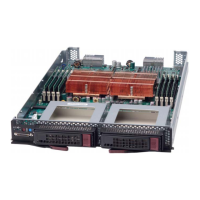5-1
Chapter 5
RAID Setup Procedure
Any blade module that supports two or more hard drives may be used to create a RAID
RAID array. For Supermicro AMD processor SuperBlade modules, only the
SBA-7121M-T1 blade module with two hard drives installed works for this purpose.
5-1 Preparing for Setup
Before you begin the installation, verify the following:
1. The blade module has two or more hard drives installed.
2. These drives must not have an OS installed and must be non-partitioned (formatted
is ok).
3. The installation procedure is done via KVM, so have a KVM cable (CBL-0218L)
connected to the KVM connector on the blade module with a keyboard, mouse and
monitor attached.
5-2 Changing BIOS Settings for RAID Configuration
Use the following procedure for changing BIOS settings for RAID configuration:
1. Boot the blade and hit the <DELETE> key to enter the BIOS setup utility.
2. In the ADVANCED SETTINGS Menu, highlight the SATA CONFIGURATION option and hit
<E
NTER>.
3. From the SATA Configuration menu screen select the NVIDIA RAID FUNCTION
setting, hit <E
NTER> to open its options and select ENABLE.
4. Go to the EXIT Menu, highlight SAVE CHANGES AND EXIT and hit <ENTER>.
5-3 Configuring RAID in the Media Shield BIOS Utility
Use the following procedure for configuring RAID in the Media Shield BIOS Utility:
1. After exiting the BIOS utility, the blade will begin to boot up. At this time press
<F10>. This brings up the M
EDIA SHIELD BIOS UTILITY screen.
2. In the MEDIA SHIELD BIOS UTILITY screen, select either MIRRORED or STRIPED as
your selection for the RAID M
ODE option.
NOTE: You may also instead use IPMI or the Web-based Management utility to
access the blade.

